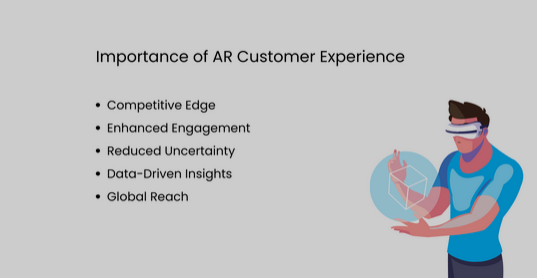Augmented Reality (AR) plays a significant role in enhancing shopping experiences by blending the digital and physical worlds. It brings interactive and immersive elements to the retail environment, both online and offline. Here are several ways in which augmented reality enhances the shopping experience:

Virtual Try-Ons:
Role: AR allows customers to virtually try on products before making a purchase.
Enhancement: This is particularly valuable in the fashion and beauty industries, where customers can see how clothing, accessories, or makeup will look on them without physically trying them on. This reduces uncertainty and increases confidence in purchasing decisions.
Product Visualization:
Role: AR enables customers to visualize products in their real-world environment.
Enhancement: For furniture, home decor, or other tangible items, AR allows customers to see how a product will fit into their homes or lives. This feature enhances decision-making and reduces the likelihood of returns.
Interactive Shopping:
Role: AR transforms static shopping experiences into interactive and engaging ones.
Enhancement: Retailers can use AR to create interactive displays or packaging that provides additional information about products, offers virtual tours, or presents interactive storytelling experiences, making the shopping journey more enjoyable.
Navigation and Wayfinding:
Role: AR can assist customers in navigating physical stores or online platforms.
Enhancement: In physical stores, AR navigation can guide customers to specific products or sections, enhancing the overall shopping experience. In e-commerce, AR can offer virtual store tours or provide 3D maps for easier online navigation.
AR Shopping Apps:
Role: Retailers can develop AR shopping apps for mobile devices.
Enhancement: These apps can leverage AR features such as scanning products for additional information, accessing exclusive content, or receiving personalized recommendations. This provides a more tailored and interactive shopping experience.
Enhanced Product Information:
Role: AR can provide additional information about products in a more engaging way.
Enhancement: By scanning products with a mobile device, customers can access detailed specifications, reviews, and multimedia content, making the decision-making process more informed and efficient.
Virtual Fitting Rooms:
Role: AR can create virtual fitting rooms for online shoppers.
Enhancement: Customers can virtually try on clothes or accessories using their devices, providing a more personalized and convenient shopping experience. This can lead to reduced return rates and increased customer satisfaction.
AR Advertising and Marketing:
Role: AR can be integrated into advertising and marketing campaigns.
Enhancement: Augmented reality can bring print or digital advertisements to life, allowing customers to interact with products or access exclusive content. This immersive approach captures attention and enhances the overall brand experience.
Gamification of Shopping:
Role: AR can introduce gamification elements to the shopping experience.
Enhancement: Retailers can create AR-based games or challenges that incentivize customers to explore products, visit physical stores, or engage with the brand. This adds an element of fun and encourages customer participation.
The role of augmented reality in enhancing shopping experiences is continually evolving as technology advances. The key is to leverage AR to provide value, interactivity, and personalization, ultimately creating a more engaging and satisfying shopping journey for consumers.
